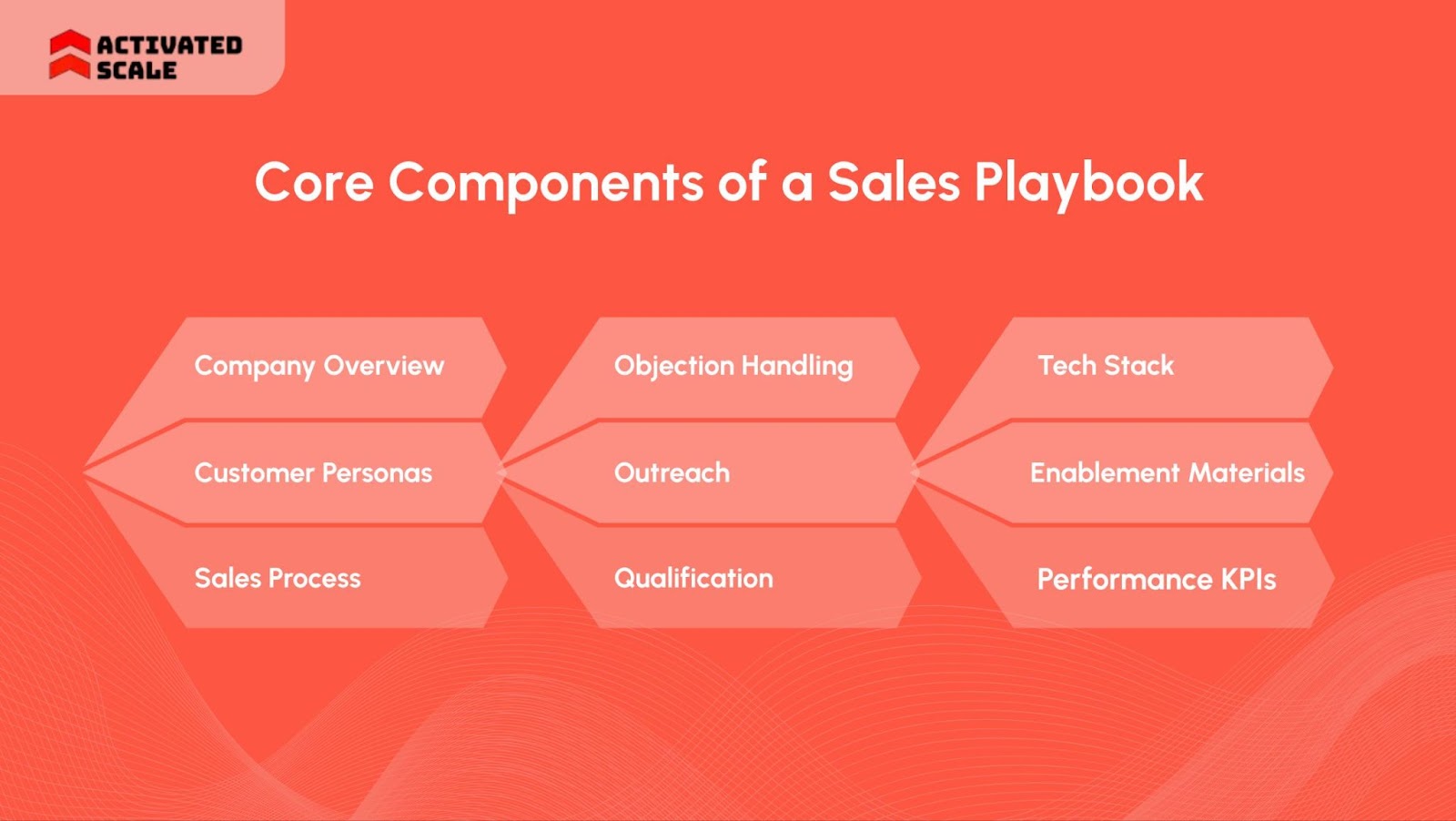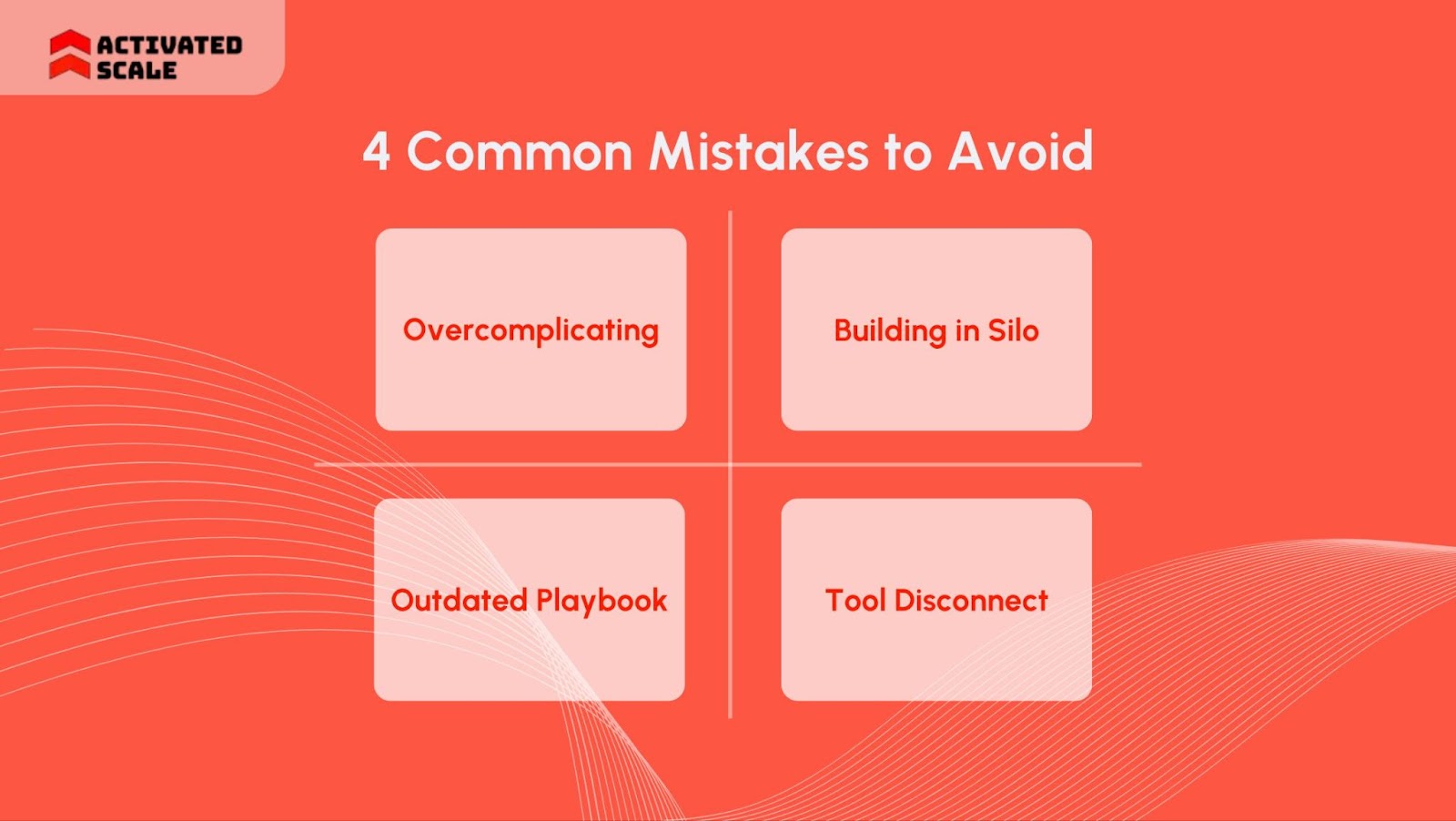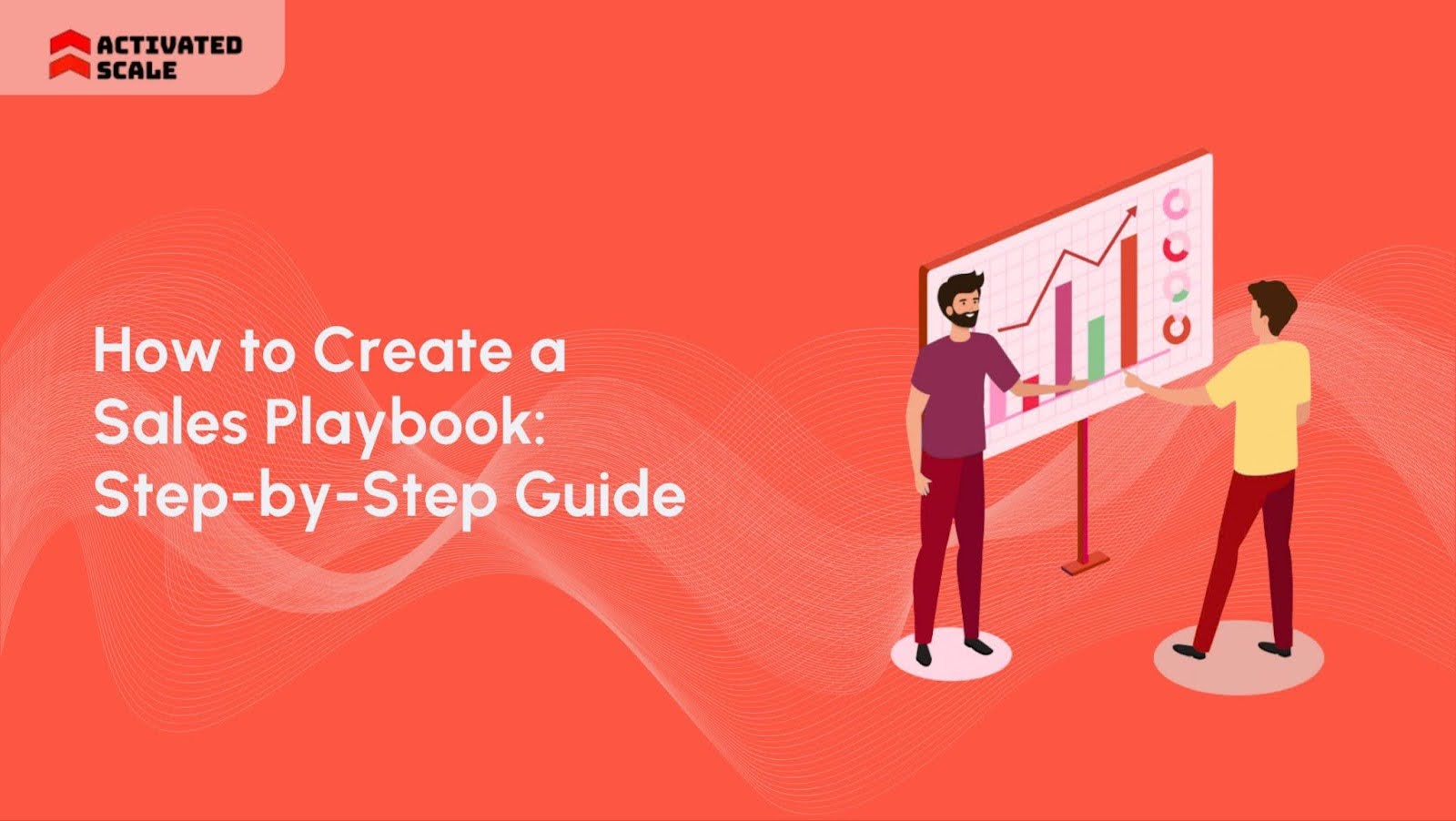Tired of answering the same sales questions over and over? Or watching part-time reps deviate off-track halfway through a pitch? One reason for this is that many early-stage startups rely on fractional sales teams today.
The model brings speed and flexibility. To achieve this, U.S. companies increased the hiring of fractional sales leaders from 5,000 to 9,000 last year.
However, not every fractional sales rep shares the same baseline. Without a shared playbook, they improvise. So, how will you create a playbook that works for your team?
In this blog, we’ll discuss how to create a sales playbook for fractional teams, step by step. Since we’ve studied what works and what falls apart across growing B2B companies, you’ll get a lean, practical guide.
Key Takeaways
- A well-structured playbook organizes your sales process, ensuring consistent performance across the team.
- For fractional teams, the playbook must be modular, easy to follow, and aligned with specific roles like SDRs and AEs.
- A great playbook includes a company overview, sales process, messaging, qualification frameworks, and tools for tracking performance.
- Don’t make the playbook too long, vague, or disconnected from actual sales tools. Involve your team and keep it updated regularly.
What is a Sales Playbook?
A sales playbook is a comprehensive guide that lays out the entire sales process for your team. It includes your strategies and a consistent approach that your sales team can follow, regardless of their experience level. Think of it as your sales team’s play-by-play manual for winning.
Who Uses It and How?
- Sales Development Representatives (SDRs): Use the playbook for prospecting tips, cold outreach scripts, and lead qualification.
- Account Executives (AEs): Use it to guide their sales conversations, handle objections, and close deals.
- Customer Success (CS) Teams: They refer to the playbook for customer onboarding processes and engagement strategies.
As we understand what a sales playbook is, let’s take a moment to consider the real-world impact of not having one.
Also Read: Why Startups Should Consider Fractional Sales Talent?
Why Your Fractional Sales Team Needs One?
You’ve assembled a team of highly skilled fractional sales reps, each bringing their expertise to the table. However, do you know that at least 59.6% fractional sales reps find it challenging to find clients?
It’s not entirely their fault. Without a unified playbook, they operate like individual players rather than a cohesive unit. This creates several key challenges:
- Inconsistent Sales Process: Each rep may approach the same lead or opportunity differently, leading to unpredictable outcomes.
- Wasted Ramp Time: New reps struggle to onboard effectively due to a lack of clear guidelines, slowing down their ability to contribute.
- Missed Targets: Without a standard approach, pipeline management becomes inefficient, and revenue targets can easily slip through the cracks.
At Activated Scale, we specialize in helping teams find reps via our Fractional Sales Leadership service. These reps will help to build effective sales playbooks customized to your unique needs.
What if there were a way to eliminate these gaps and ensure your fractional sales team performs with a unified approach? That’s where a sales playbook becomes indispensable.
9 Core Components of a Sales Playbook

A sales playbook is built on several core components that together provide an actionable approach. Each part serves a distinct purpose. Let’s break down these essential elements:
1. Company and Product Overview
A solid sales playbook starts with a clear understanding of the company’s mission, vision, and the products or services you offer. This section ensures that all sales reps, whether new or experienced, have the foundational knowledge.
- Company Mission and Values: This helps reps align with the core principles of the organization. They should reflect the company’s voice when interacting with prospects.
- Product Knowledge: Detailed information about the product’s features, benefits, and use cases enables reps to position the solution accurately.
- Unique Selling Proposition (USP): Outlining what makes your product stand out gives sales reps confidence. They can articulate the advantages over competitors. This is so important to your consumers that 47% of them turn to a local company for their purchase decision.
So, if you want to stand out, your reps must know how to sell your product that builds trust even if you are not local.
- Competitive Market: Understanding competitors and the market helps reps position the product more effectively during conversations.
2. Ideal Customer Profile and Buyer Personas
Defining who your ideal customer is and understanding the buyer personas is key for effective prospecting. This section helps sales teams target the right customers and optimize their outreach efforts.
- Ideal Customer Profile (ICP): Describes the characteristics of the businesses or individuals who are the best fit for your product. It guides reps in targeting high-value leads.
- Buyer Persona: This shares a detailed description of your target customer’s demographics, behaviors, and challenges. Reps customize their messaging to the needs and pain points of specific personas.
- Customer Segmentation: Segment prospects based on characteristics like industry, company size, or job title.
- Customer Journey Mapping: Understanding the stages your customers go through. It will help reps engage at the right touchpoints with the right message.
3. Sales Process (Stage-by-Stage)
The sales process is the backbone of any playbook. It’s important to map out the entire journey from lead generation to closing the deal. This section breaks down each stage of the funnel so reps know exactly what to do and when.
- Lead Qualification: Define criteria for what makes a lead “qualified” at each stage. Reps should know how to score and prioritize leads to avoid wasting time on unqualified prospects.
- Discovery Phase: Outline the key questions and strategies reps should use to uncover prospect needs. Make sure that these solutions are discussed during initial conversations.
- Proposal and Negotiation: Provide templates and guidelines for creating personalized proposals and handling price discussions to increase the chances of closing.
- Closing the Deal: Clearly define what constitutes a successful close. A step-by-step guide on “how to lead the prospect through the final steps” may work.
4. Sales Objection Handling
Sales messaging and objection handling are integral parts of a playbook. Reps need clear and concise messaging to handle objections confidently.
- Value Propositions: Outline the key benefits your product offers, so your reps can solve specific pain points for prospects.
- Elevator Pitch: Provide a compelling pitch that reps can use to capture a prospect’s attention during the first touchpoint quickly. 57% of sales calls contain negative emotions from leads. To overcome this smartly, a right pitch is necessary.
- Common Objections: Identify and address typical objections along with battle-tested responses to handle them effectively. This includes price concerns, product fit, or competitor comparisons.
- Customized Messaging: Ensure reps know how to adjust messaging based on different buyer personas and industry-specific challenges.
Tap into experienced SDRs and AEs through Activated Scale’s Fractional Selling service. Get access to every rep who knows what they are doing.
5. Prospecting and Outreach
Effective prospecting and outreach are critical for generating quality leads and building a robust pipeline. This section provides the tools and strategies sales reps need to initiate meaningful conversations with prospects.
- Cold Call Scripts: Offer proven scripts for different types of cold outreach, whether it’s for new leads or re-engaging dormant prospects.
- Email Templates: Provide email templates for different sales stages, from initial outreach to follow-ups.
- Multichannel Outreach: Emphasize the importance of using multiple channels such as phone, email, and social media. Ensure to integrate them into a cohesive outreach strategy.
6. Qualification Framework
A qualification framework ensures that sales reps assess whether a lead is worth pursuing. This section outlines different frameworks that can help reps prioritize high-potential opportunities.
- BANT (Budget, Authority, Need, Timing): A straightforward approach for determining whether the prospect has the budget and authority to make decisions.
- MEDDIC (Metrics, Economic Buyer, Decision Criteria, Decision Process, Identify Pain, Champion): A more in-depth qualification method that helps reps assess the entire buying process and identify key stakeholders.
- SPICED (Situation, Pain, Impact, Critical Event, Decision): It focuses on understanding the prospect’s pain points and critical events. This also helps reps position solutions in a way that directly addresses these needs.
- Opportunity Scoring: Create a scoring system to evaluate how likely a prospect is to convert, based on criteria. That can be engagement level, industry, and product fit.
7. Tools and Technology Stack
This section provides an overview of the tools and tech stack your sales team should be using to increase productivity and manage the sales process efficiently.
- Customer Relationship Management (CRM) System: Clarify how representatives should log every touchpoint in your CRM, such as HubSpot or Salesforce, to prevent duplicate outreach. For example, each rep must tag contacts by deal stage and next action. This builds pipeline visibility, especially when multiple reps rotate on an account.
- Calling Tools: Include guidelines for using tools like Aircall or Dialpad. For instance, reps should always use local presence dialing and log call outcomes after each attempt. Outline how sequences are triggered so they don’t accidentally skip a lead.
- Analytics Dashboards: Teach reps how to interpret key metrics and performance data to improve their strategies and close rates.
- Sales Enablement Platforms: Show reps how to use tools like Showpad or DocSend. For example, when sending a proposal, always include tracking links so you know when a buyer reads it. That data helps time your follow-up perfectly.
8. Sales Enablement Materials
Sales enablement materials are essential assets that support sales reps throughout their process. This section provides guidance on which materials to use and when.
- Sales Pipeline Templates and Playbooks: Include templates for proposals, email outreach, and qualification processes.
- Sales Decks and One-Pagers: Provide guidelines on when and how to use product decks and one-pagers. Fractional reps can effectively communicate value during meetings and presentations without going through multiple pages.
- Case Studies: Equip reps with real-world examples of how your product has helped similar customers. This enhances credibility during sales conversations.
9. KPIs and Performance Benchmarks
Tracking performance is key to measuring success. This section focuses on the key performance indicators (KPIs) and benchmarks to enhance team performance.
- Activity Metrics: Track sales activities like calls, emails, and meetings to ensure reps are staying active and engaging with enough prospects.
- Outcome Metrics: Measure conversion rates, win rates, and deal sizes to assess how effectively the team is closing opportunities.
- Weekly Scorecards: Implement a scorecard system that helps reps measure their progress against set goals.
- Team-wide Metrics: Establish team-wide goals for overall pipeline health and revenue generation to ensure everyone is working toward the same targets.
Also Read: Essential Sales Development KPIs for Maximizing Team Success
You’ve got the blueprint, the 9 must-have components of a great sales playbook. However, knowing what to include isn't enough. Let’s walk through how actually to put your sales playbook together, step by step. So your fractional reps know how to use them with precision.
How to Build Your Sales Playbook for a Fractional Team (Step-by-Step)?

Building a sales playbook is a systematic process that requires strategic thinking and collaboration. Follow these steps to create a playbook that aligns with your sales team's needs and objectives.
Step 1: Define Audience and Goal
Before diving into the details, identify who the playbook is for and what you aim to achieve. Understanding the audience helps customize the content effectively, whether it’s for SDRs, AEs, or CS teams. Set clear goals, such as improving lead conversion or streamlining onboarding, to guide the structure.
Step 2: Interview Top Reps
The best way to build a relevant playbook is to tap into the expertise of your top-performing reps.
Conduct interviews to capture their strategies, techniques, and insights. These frontline experiences will provide valuable content for your playbook and ensure it's grounded in real-world practices.
Step 3: Map Your Sales Process
A successful playbook outlines each stage of the sales funnel, from lead generation to closing the deal. Break down your sales process into clear, actionable steps. Ensure it reflects your ideal customer journey. Don’t forget to include who owns each stage, so everyone knows their responsibilities.
Step 4: Write in Modular Sections
A playbook is most useful when it’s modular, allowing for easy updates and additions. Write each section as a standalone unit, focusing on key areas like sales messaging. This approach makes it easier to train new hires and keep the content current.
Step 5: Test and Get Feedback
Once you have a draft, test the playbook with your sales team. Gather feedback on what works and what doesn’t, then iterate based on their insights. This ensures the playbook is not only comprehensive but practical and effective in the field.
Step 6: Train and Activate
Training is crucial to the success of any playbook. Schedule training sessions where reps can learn how to use the playbook and incorporate its strategies into their day-to-day activities. Engage in role-playing and provide hands-on practice to ensure retention.
Step 7: Keep It Alive (Review and Update Quarterly)
A playbook should evolve as your team’s needs change. Review and update the content quarterly to keep it fresh and aligned with new products.
Ready to build a sales playbook that drives success? At Activated Scale, our Contract-to-Hire Sales Recruiting service helps you hire vetted sales professionals on a flexible, trial basis.
While the structure and content are key, there are several common mistakes teams often make. Since it can undermine reps’ efforts, it’s important to understand those closely.
4 Common Mistakes to Avoid

Creating a sales playbook is just the beginning. The real challenge lies in ensuring it’s practical, adaptable, and effective. Avoid these frequent mistakes to get the most out of your playbook:
1. Overcomplicating or Oversimplifying It
Too much detail overwhelms reps, while too little leaves gaps. So, keep it actionable, with just enough detail to guide reps without overwhelming them.
2. Building It in a Silo
A playbook created without input from reps often misses key insights. Collaborate with your sales team to ensure the playbook reflects real-world challenges and strategies.
3. Failing to Update It
An outdated playbook quickly loses relevance. Regularly review and update it to align with growing sales strategies and customer needs.
4. Disconnecting It from Tools and Deals
A playbook that isn’t integrated with your sales tools becomes hard to apply. Link it to your CRM and sales enablement tools for seamless use and better results.
With a solid sales playbook in place, these challenges become manageable.
Read Also: Becoming a Remote Sales Representative: Job and Employment Opportunities
Conclusion
A sales playbook is the backbone of any successful sales team. It’s the framework that drives consistency and growth in your team. You can ensure that every rep has the tools to succeed by clearly defining expectations.
If you are still wondering how to create a sales playbook for fractional teams, consider the value it can bring in aligning your team. Now, it’s up to you to take that first step and bring the full potential of your sales process.
At Activated Scale, we specialize in helping businesses provide the most experienced sales reps. Book a Call now if you are interested in bringing reps who can help build playbooks.
FAQs
1. How to create a sales playbook for fractional teams?
To create a sales playbook for fractional teams, start by defining the roles and responsibilities of each fractional sales rep. The playbook should cover the entire sales process.
2. How to create a sales playbook for fractional teams for free?
Creating a free sales playbook for fractional teams involves using accessible tools like Google Docs or Notion.
First, map out your sales process and break it down into clear, actionable steps. Next, create easy-to-follow templates for emails, calls, and objection handling. Finally, organize the content in a modular format so it can be updated as needed.
3. What is a sales playbook template?
A sales playbook template is a structured document that outlines a company’s sales process, strategies, and tools. It includes sections on the company’s mission, product details, ideal customer profiles, objection-handling techniques, sales scripts, and performance metrics.
This template helps standardize sales activities so all team members are aligned with the company’s sales goals.
4. What are the best sales playbook examples available?
The best sales playbook examples come from companies that have perfected their sales strategies. Some top examples include:
- The HubSpot Sales Playbook: This playbook provides a comprehensive framework for inbound sales, including templates for emails, discovery calls, and follow-ups. It focuses on building relationships and offers detailed processes for lead nurturing and closing.
- The Sandler Sales Playbook: Known for its customer-centric approach, this playbook emphasizes solving problems before pitching products. It includes specific guidelines for managing objections and closing deals.
These examples provide actionable steps that can be adapted for different industries and sales teams.
The Ultimate Guide to Hiring a Salesperson!
Get the step-by-step guide to hiring, onboarding, and ensuring success!
_edi.png)




